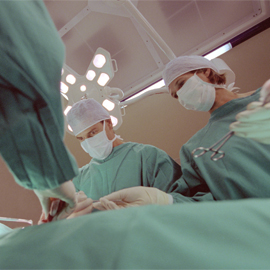
Weight loss surgery has emerged as one of the most effective methods for helping morbidly obese people achieve long-term weight loss success. Weight loss surgeries, unlike diet and exercise or weight loss medications, actually change how your body responds to the food you eat.
These physical modifications can help obese people make permanent lifestyle changes that allow them to not only lose a significant amount of weight, but to keep the weight they’ve lost off.
How does weight loss surgery work?
How weight loss surgery helps you lose weight depends on which type of procedure you have. There are three basic types of bariatric surgeries.
- Restrictive procedures: These procedures limit the amount of food you can eat by sectioning off a portion of the stomach. By eating less, you consume fewer calories and will lose weight. Restrictive procedures do not change the normal function of the intestines. Examples of restrictive procedures include adjustable gastric banding and sleeve gastrectomy.
- Malabsorptive procedures: These procedures change the way your body absorbs and digest the food that you eat. While you may be eating the same amount of food, only a small portion of the calories in your food will be absorbed by your body. The duodenal switch bypass is one example of a malabsorptive procedure.
- Combination of restrictive and malabsorptive procedures: Some procedures, like gastric bypass surgery, reduce the amount of food you can eat in one sitting and limit how much food is absorbed by your intestines.
Your surgeon can help you determine which type of procedure is best for you based on your current health, lifestyle, and weight loss goals.
What are the benefits of weight loss surgery?
Weight loss surgery, as the name suggests, is designed to help morbidly obese people lose a significant amount of weight. However, the benefits of losing weight go beyond cosmetic improvements. There are several obesity-related health complications that can be resolved by having weight loss surgery. Bariatric surgery has been proven to be an effective treatment option for: diabetes, high blood pressure, sleep apnea, gastric reflux disease, heart disease, and respiratory problems.
Is weight loss surgery safe?
There is a risk of complication associated with any surgery, and bariatric procedures are no exception. Your specific risks will vary depending on your overall health, weight, and the type of procedure you elect to have. While the overall risks associated with weight loss surgery are low, it’s important to be aware of the possibility of serious complications, including death. Your surgeon can talk to you about steps you can take to reduce your risk for surgical complications, like quitting smoking several months before your operation.
Who should get weight loss surgery?
Weight loss surgery is designed to address the medical problems associated with obesity. People with a body mass index (BMI) of 40 or higher are considered morbidly obese and are generally eligible for weight loss surgery. People who have a lower BMI and already have obesity-related health conditions may also be good candidates for weight loss surgery. Your physician can help you evaluate the potential risks and benefits of weight loss surgery and which procedures might be right for you.
Types of Weight Loss Surgery
Gastric Banding
Gastric banding is classified as a restrictive weight loss surgery. It helps morbidly obese people lose weight by significantly reducing the amount of food that can be eaten, but does not affect the way the body absorbs nutrients. Gastric banding is the simplest and least invasive of all weight loss procedures.
During gastric banding surgery, an adjustable band is placed around the top portion of the stomach. An access port, which is connected to the band by a tube, is also attached under the skin in the abdomen. A saline solution is then injected into an inner balloon inside the band by way of the access port. As the inner balloon fills with fluid, the band tightens around the top portion of the stomach and forms an upper pouch.
This pouch typically holds about 4 ounces of food. The tightened band holds the 4 ounces of food in the upper pouch until it has been digested by the stomach acids, giving you the sensation of being full. Once the food has been digested, it will continue to pass through the rest of the digestive tract normally. By restricting the patient to eating only 4 ounces at a time, the patient is able to drastically reduce the number of calories consumed and lose a significant amount of weight.
Gastric banding is a reversible weight loss surgery, although the band is made of safe materials that can remain in the body permanently. The procedure is almost always performed laparoscopically.
Sleeve Gastrectomy
A sleeve gastrectomy is a restrictive weight loss surgery that drastically reduces how much food you can eat in one sitting.
During a sleeve gastrectomy, the curved portion of the stomach is stapled and removed, leaving a stomach sleeve that is about the size of a banana. Comparatively, a regular-sized stomach is about the size of a football. This new stomach only holds about a half a cup of food, while still allowing you to feel satisfied.
No changes are made to the small intestines during a sleeve gastrectomy. Food enters and leaves the stomach the same way as it did before surgery, and the rest of the digestive system is left intact.
In some cases, sleeve gastrectomies are performed before a gastric bypass surgery or biliopancreatic diversion with duodenal switch. This may be done if a patient is not yet considered a good candidate for gastric bypass surgery or biliopancreatic diversion, or to help the patient adjust to eating smaller amounts of nutritious foods before making further changes to the digestive system. However, a sleeve gastrectomy can be used as a stand-alone weight loss treatment.
In most cases, a sleeve gastrectomy is performed laparoscopically and patients are usually fully recovered within 3 weeks.
Gastric Bypass Surgery
Gastric bypass surgery combines restrictive and malabsorptive techniques to reduce your overall caloric intake. The procedure can be performed laparoscopically, through a few small, keyhole incisions, or through a long incision in the abdomen. It’s very effective for people who are looking to lose a significant amount of weight.
The first part of gastric bypass surgery involves making your stomach smaller so that you can only eat a limited amount of food while still feeling full. A stapling device is used to separate a small piece of the top of the stomach from the rest of the stomach. The top portion becomes the new, smaller stomach that is used to hold food, while the rest of the stomach is closed off and no longer accessible.
In addition to reducing your stomach size, gastric bypass surgery also bypasses part of the digestive tract so that your body absorbs fewer calories from the food you do eat. Using a stapling device again, a portion of the small intestine is cut. The lower piece is then connected to the new pouch stomach that was created in the first part of the procedure. The upper part of the small intestine, which carries the bile and enzymes needed for digestion, is then reconnected to the intestine further down the digestive tract. Now the bile and enzymes won’t mix with your food until further down the intestines, which means there is less time for food digestion and calorie absorption.
The combination of these two changes to the body allows you to feel full on less food and go a longer period of time between meals. While this operation does require major manipulation of the digestive system, it is a very effective and relatively safe weight loss surgery, especially for people who struggle with portion control.
Biliopancreatic Diversion
A biliopancreatic diversion, like the gastric bypass procedure, utilizes both restriction and malabsorption to affect weight loss.
The biliopancreatic diversion (BPD) can be performed on its own or with a duodenal switch. During a biliopancreatic diversion, the lower part of the stomach is removed. The portion of the stomach that is left holds about 6 ounces of food, a larger reservoir than what is routinely left with gastric bypass surgery. The remaining portion of the stomach is then connected to the ileum, the lowest part of the small intestine. In this procedure, the duodenum, the first part of the small intestine, and jejunum, the middle part of the small intestine, are bypassed.
During the biliopancreatic diversion with duodenal switch (BPD-DS), only the outer curve of the stomach is removed. The pyloric valve, the valve at the bottom of the stomach that regulates the release of contents into the small intestine, is left intact. The duodenum is then hooked up to the ileum, bypassing only the jejunum.
Some researchers and surgeons feel that the use of the DS can increase weight loss, decrease the need for revision, result in fewer side effects, and improve the absorption of nutrients as compared to the original BPD procedure.
In both procedures, bile from the liver and other digestive enzymes are carried to the lowest part of the small intestine by a separate pathway. This rerouting allows food to travel farther through the digestive tract without being digested, and fewer calories to be absorbed by the body.


